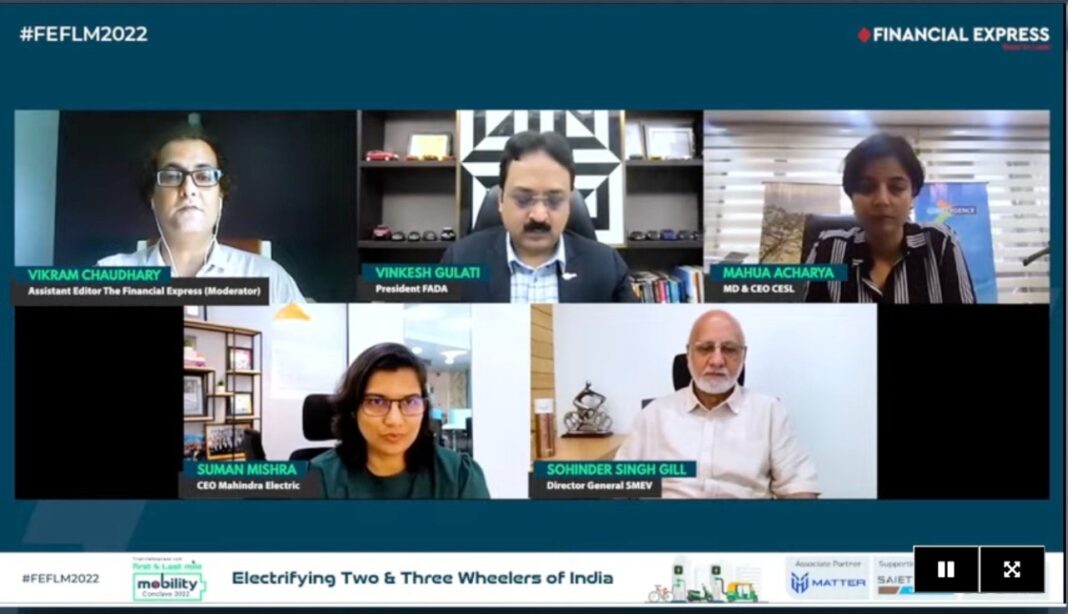Electric vehicles are gradually gaining popularity in the Indian market, especially in the two- and three-wheeler segments. While there are multiple reasons for the same, the FAME-II (Faster Adoption and Manufacturing of Electric and Hybrid Vehicles in India) subsidy from the central government and the state government incentives can be attributed as the most lucrative factors for the general consumers. However, the FAME-II subsidy has its own limitations as well.
It was introduced in April 2019 with an outlay of Rs 10,000 crore for a period of 3 years, which was later extended by another two years and is now valid till March 31, 2024. So, what’s the road ahead of FAME-II and state incentives? To understand the same better, we had with us various panellists at the First & Last Mile Mobility Conclave 2022 hosted by The Financial Express. The eminent panellists included Ms Mahua Acharya, MD & CEO, Convergence Energy Services (CESL); Mr Sohinder Gill, DG, Society of Manufacturers of Electric Vehicles (SMEV); Ms Suman Mishra, CEO, Mahindra Electric and Mr Vinkesh Gulati, President, Federation of Automobile Dealers Associations (FADA).
The session was moderated by Mr Vikram Chaudhary, Assistant Editor, The Financial Express. Talking about subsidies on EVs globally, while China might eliminate the incentives by the end of this year, the European Union and the US will continue with them in the near future. On being asked what India can learn from these developed markets and the future of FAME-II, Acharya revealed that the amount of money India is willing to spend on EV subsidies is much less than that of developed countries.
Moreover, she adds that subsidies won’t go away as India really need subsidies to utilise the funds as the financial health of the state transport authorities aren’t sound enough. Gill believes that subsidy is relevant as it brings down the cost for general consumers. But, he addressed that with increasing sales volume, the subsidies might get tapered before the deadline.
When asked should the nature of EV subsidies be changed in India, Gill said that it should be gradually shifted from one benefit to another. For instance, the battery swapping policy is coming very well in India and in parallel it could be subsidised. Acharya said that CESL is trying to get interoperability with standard charging points, locating charging stations on mobile apps among others.
The panelists shared their opinions about the standardisation of battery swapping centres and the challenges associated with it. It is believed to be well perceived in the cargo industry. Mahindra Electric’s Mishra said that when logistics and cargo vehicles are plying on a fixed route, the swapping centres could be installed right in the middle of the route for better asset utilisation.
Since EVs have far less moving parts than conventional ICE vehicles, will the profitability of dealerships reduce once EVs become mainstream as they rely on aftersales service for the same? Responding to this, Gulati said that as of now servicing of EVs aren’t a good business. However, the swappable batteries could become a viable business for dealerships as they are widespread within a small radius of kilometre not just inside the city but even on highways. Watch the full video of this insightful discussion and know more details about The Financial Express’ First & Last Mile Mobility Conclave 2022 by clicking here.
.
From: financialexpress
URL: https://www.financialexpress.com/express-mobility/vehicles/electric-vehicles/first-last-mile-mobility-conclave-subsidies-will-continue-to-help-drive-ev-adoption/2564427/



